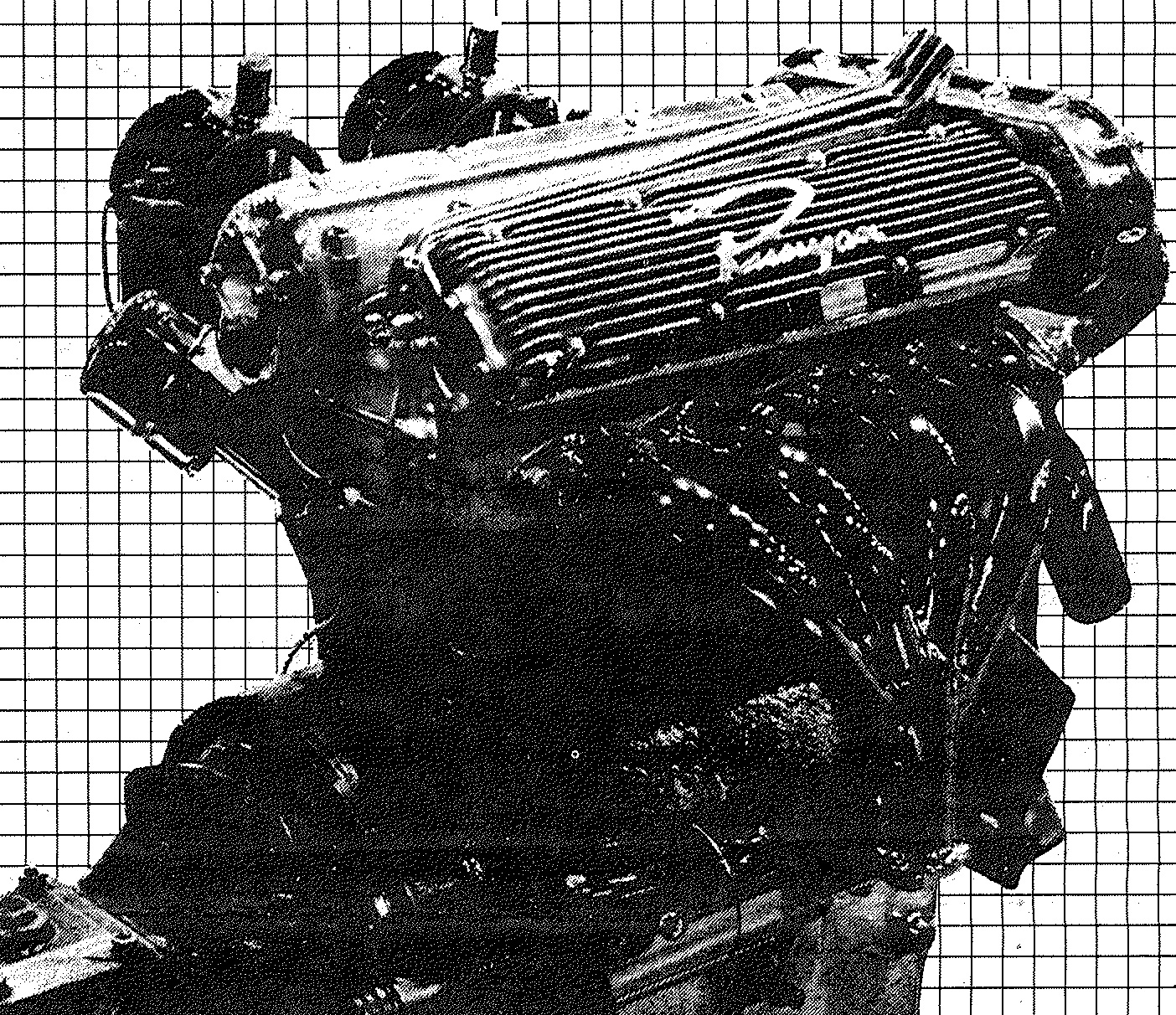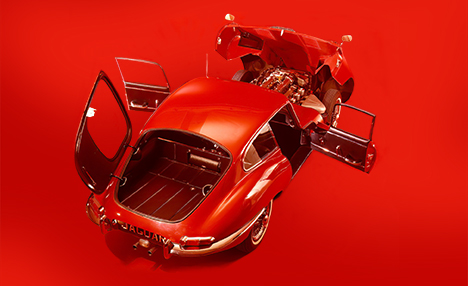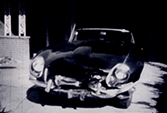From Moss Motoring 1985
by Lawrie Alexander
 The double overhead camshaft engine fitted to the MGA Twin-Cam models was known as much for its notorious unreliability as for its 108 bhp output. Clearly, this head design extracts more power from a given displacement and some manufacturers achieved solid commercial success with it (Alfa Romeo, Fiat, Jaguar, to name just a few). MG, however, discontinued the twin-cam in the face of poor sales and thus the only post-war MG factory engine of this design passed into history.
The double overhead camshaft engine fitted to the MGA Twin-Cam models was known as much for its notorious unreliability as for its 108 bhp output. Clearly, this head design extracts more power from a given displacement and some manufacturers achieved solid commercial success with it (Alfa Romeo, Fiat, Jaguar, to name just a few). MG, however, discontinued the twin-cam in the face of poor sales and thus the only post-war MG factory engine of this design passed into history.
Few historians have documented other, non- factory supported attempts to produce twin-cam MG engine conversions. Realizing the performance potential of the double overhead cam head, a number of privateers in the U.S.A experimented during the 1950’s. All shared a common goal to make a race-car go faster. Sadly, they all also met the same lack of success. Here we will deal with four variations of the twin-cam theme, based on XPAG/XPEG blocks. Two are fairly well known, thanks to publicity in the ‘Hot Rod” press at the time they were built. The other two are virtually unknown and this is the first documentation of their history and their existence.
THE UIHLEIN TWIN-CAM
Readers of the September, 1953, issue of ‘Speed Age’ were treated to a cover shot of a low, sleek two-seat racer, and a 3- page story on what the editors called…’ a serious threat to foreign domination of the 1.5 liter class’. Built in Milwaukee, the brainchild of David V. Uihlein, the aluminum body topped a modified TD chassis. Under- hood lay the twin cam, XPAG derived engine designed by Weikko Leparen, reputed to give 90 bhp.
The head and cam housings were cast of nickel-alloy steel and provided 360 degree water cooling around the 1 7/16″ valves The cams were gear driven from the crankshaft via an all new gear drive arrangement, although the original cam remained to drive the oil pump and distributor. Combustion chambers were hemispherical with centrally located spark plugs. Dual SLTs were mounted on the left and four long, straight pipes exited on the right. Speed Age reported “The Uihlein special retired with minor mechanical trouble in its initial test at the Chanute Field sports car event at Rantoul, IL, on June 14th. But Uihlein and his companions in this venture are confident the bugs common to any new design will be eliminated’. Sadly, this was not to be! There are no known reports of the car ever performing in a convincingly successful manner.
THE RUNYAN TWIN-CAM
March, 1956, saw an XPAG-based twin cam engine publicized in ‘Hot Rod’ magazine. Not a great deal of information was given, but dynamometer readings of 78 to 80 bhp were reported, and over 110 bhp was projected for the engine in its final development stages.The engine was developed by Dale Runyan, Bill Zimmerman, and Norman Timbs, presumably in the Los Angeles area. It was to be offered as a $500 kit but no mention was made in the article as to where you could buy one of these kits. Whether many people did, or if the engine was ever successful, remains undocumented. Two are known to exist today, although neither is installed in a car or running.
THE KEN MILES TWIN-CAM
This one surfaced in 1977, when a chap showed up in Santa Barbara with photographs of a TC engine with a double-overhead cam head. Shortly thereafter, Chris Nowlan (Moss Motors’ Product Development Manager) purchased the engine and an assortment of spare parts.
The engine was, in fact, built around one of the factory 1500 competition blocks made for the EX 179 Record attempt in August 1954. The head, machined from a solid billet of aluminum and extensively decorated by damascening (a’ la Bugatti!), had hemispherical, combustion chambers, two cams chain driven via an idler on the original camshaft, a Lucas magneto driven off the rear of the exhaust cam and provision for a dry sump system. No induction system was fitted but the spare parts included four Amal motorcycle carburettors which neatly bolted to the head. Likewise, there was no exhaust manifold, just four stub pipes off the head. An interesting note was that the firing order was 1 -4-3-2, although the crank and rods were stock TF 1500 with high-top pistons. The engine had obviously been run, had seized up from lack of oil (#3 rod bearing had spun) and the block bore evidence of an external fire on the exhaust side. The likeness to a TC engine came from the fact that the motor had a narrowed TC front bearer plate.
Many months of enquiries shed no light on the engine’s history. Eventually, it became reasonably certain that it had been built by Ken Miles for his second famous MG special, ‘The Flying Shingle’. Miles had been one of the drivers (along with George Eyston) of EX 179 and rumor had it that a number of the spare engine parts were Ken’s’ thank-you’ from his involvement in the successful record attempt.
Both Miles specials had used TC bearer plates, and the centers on the engine fit exactly the mounts on ‘Shingle’s’ chassis. This was confirmed by’Shingle’s’ present owner, who also found that the specially built dry sump oil pan included in the spares Chris bought fit the chassis layout perfectly. ‘Shingle’ used a TC gearbox and the engine’s lightened flywheel was an early, small flywheel which had been modified to run an 8″ clutch in a TC bellhousing. The most positive clue came from one old-time racer who remembered seeing ‘Shingle’ driven in a club event between the one full season Miles raced ‘Shingle’ and the next year when he first drove the ‘Pooper’, or Porsche-Cooper special. This was probably ‘Shingle’s’ last outing in Miles’ hands and the old-timer remembers it retired when an oil line broke and caused an engine fire ..! Not proof that it was Miles’ engine but enough circumstantial evidence to sway most juries!
Where is it now? Don Martine of Pacific Grove, California acquired it from Chris and fitted it, reworked, to a TC special which first appeared at the Santa Barbara GOF in 1982. The car was then raced in a few West Coast Vintage events, putting up some very creditable lap times. Unfortunately, it also suffered many minor problems; culminating in a dropped valve. It now awaits further development.
THE PUMA TWIN CAM
In 1980, a chance meeting led Lawrie Alexander (Moss Sales Manager) to another one-off twin cam conversion.
PUMA an acronym for Purdy-Muller Associates, was the name given to this head which was built in 1955 by Hatton Purdy and Rudy Muller in Los Angeles. Rudy was a patternmaker who had built a number of such heads for V-8 engines; Hatton was a machinist and sometime racer. They had planned to race this engine a TD, then sell complete kits, but never went beyond the first engine.
The head was cast aluminum as were the valve covers, water manifolds, timing chain covers and numerous small fittings. The cams were specially made, operating directly on valve buckets (similar to the Jaguar set-up), driven by gears from a chain driven centered gear. Two induction systems were prepared, one using two 1/2” SUs on a log manifold the other with a pair of homemade (!) twin-choke SUs on a direct-feed manifold! A T-series water pump was mounted to one side of the new timing cover, cooling the engine via special manifolds.
After acquiring the engine, Lawrie found the reason the project was abandoned: the head was cracked. After several attempts to repair what proved to be a very porous casting, the engine eventually went together and was installed in a TD for its first real test drive-3,400 miles to GOF in Victoria, EG, and back. This trip proved the conversion had potential, so the engine was removed for additional work to cure its numerous oil leaks around the head and cam drive gear. It is also being fitted with re-profiled camshafts (to enable the timing and clearances to be set with less guess work), and different carburetion. If all goes well, it will reappear later in 1985 fitted to Lawrie’s boat-tailed TD race-car.
So, in a world where many MGA Twin Cams are still cherished by their owners, there are four known twin-cam versions of the XPAG/XPEG design. Are there more?








'Unique MG Twin Cams' has 1 comment
July 9, 2018 @ 6:37 am Roger
In what cars was this engine mounted?